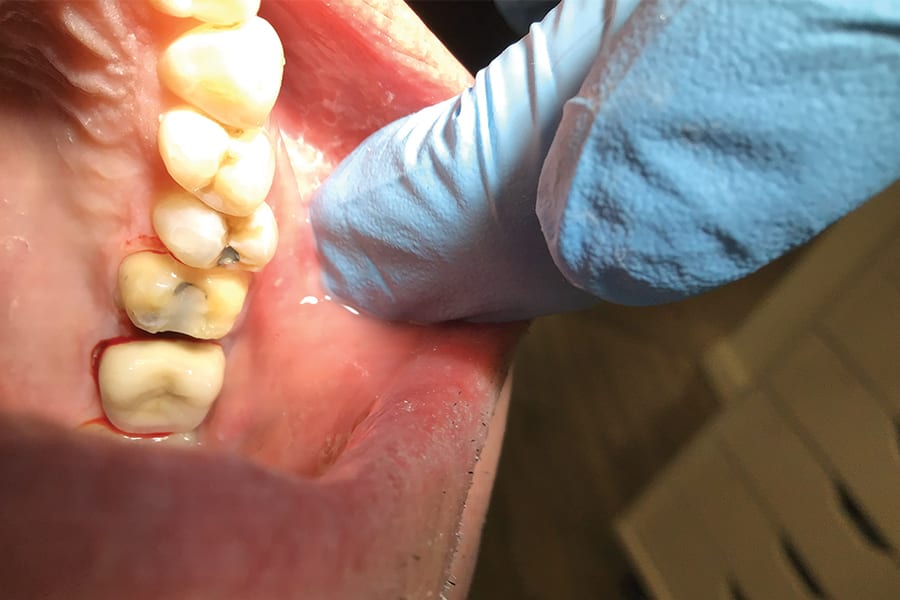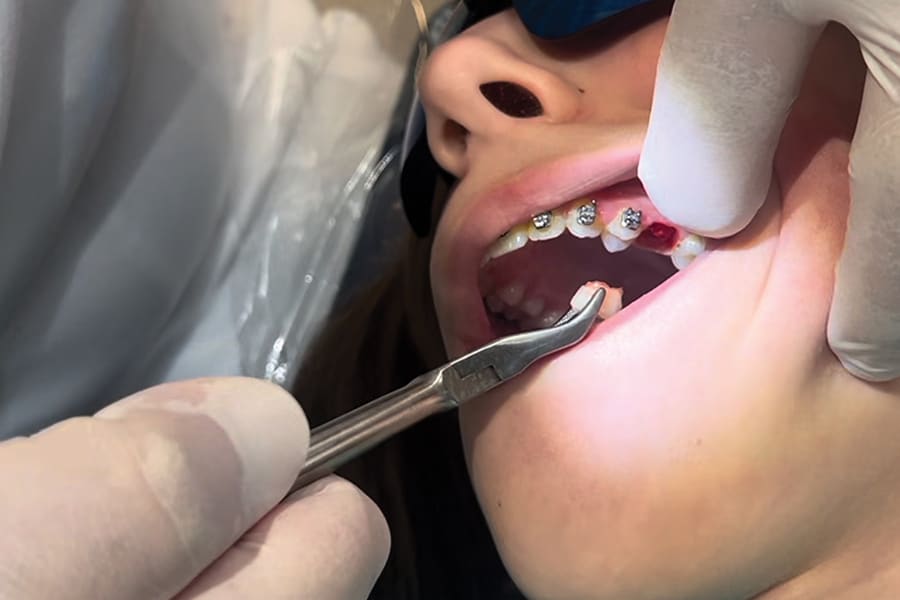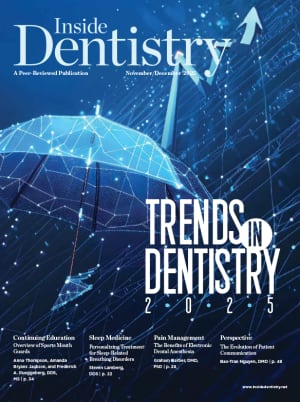On a daily basis, general dentists are faced with the fact that millions of Americans avoid them because of their fear of pain and/or needles. This problem is compounded by the fact that many patients avoid basic restorative dental procedures until pain forces them to see a dentist. Unless basic restorative dental procedures become more comfortable and less stressful for patients, dental anxiety will continue to prevent many patients from seeking necessary dental care.
Dental anesthesia plays a crucial role in ensuring patient comfort during various dental procedures. It can be broadly categorized into topical anesthesia, which involves applying an anesthetic agent to the surfaces of the mucous membrane to numb the area, and local anesthesia, which involves injecting an anesthetic agent near the site where the procedure will be performed.
In modern dentistry, innovative technologies are revolutionizing the way that dental procedures are performed, particularly in the realm of pain management. One such advancement, needle-free electronic dental anesthesia, can offer a noninvasive alternative to traditional chemical topical and injectable anesthesia.
Making Injections More Comfortable
For many years, topical benzocaine gel has been a staple of every general practice. Benzocaine reversibly blocks pain reception in the gingiva and is generally applied to injection sites prior to the injection of a local anesthetic. The various benzocaine topical gels that are available come in a multitude of flavor options, and when paired with careful local anesthetic administration techniques, their application can reduce the discomfort associated with local injections.
Similarly, the use of buffered lidocaine can also help to reduce the discomfort associated with anesthetic injections. Buffering, which is achieved by mixing sodium bicarbonate with the lidocaine just prior to administration of the injection, is thought to reduce some of the burning sensation associated with the acidity of lidocaine anesthetic. The pH of plain lidocaine is approximately 6.2 to 6.3, whereas buffered lidocaine has a pH of approximately 8. However, it should be noted that a recent double-blind clinical trial of buffered lidocaine found that it provided no discernible benefit to dental patients.1 Therefore, the main benefit of buffering lidocaine may be that it makes the anesthetic faster acting because lidocaine has a pKa of 7.9 pH. The act of buffering allows the anesthetic to dissociate into its active form prior to injection and presumably reduces the amount of time that it takes for it to numb the patient. Buffered lidocaine facilitates highly effective local anesthesia during emergency scenarios in which patients present with an active infection in need of drainage.
Another method that is used to reduce the discomfort associated with anesthetic injections involves mechanical stimulation of the injection site. In this method, a commercially available handheld unit is used to conduct high-frequency vibrations into the gingiva in the area of the injection site prior to injection. This is thought to reduce the pain signals that are transmitted to the brain during anesthetic injections. Although such devices have not been shown to reduce the time that it takes to inject an anesthetic, they have been shown to reduce the pain associated with dental injections when they are applied to injection sites for approximately 15 seconds prior to the injection.2
Needle-Free, Electronic Anesthesia
Needle-free, electronic dental anesthesia is now an option for use in general restorative dentistry, eliminating the need for traditional injectable anesthetic in many cases. Neuromodulation devices can achieve needle-free anesthesia by using high-frequency, bi-phasic peripheral nerve stimulation to reversibly block the transmission of pain to the brain (Figure 1). With these devices, it is possible to remove caries and prepare teeth for restorations without any other form of anesthetic.
Especially effective on the sensitive periodontal complex, neuromodulation inhibits nerve propagation to offer both immediate and sustained pain relief. Clinical studies have validated its efficacy in achieving significant pain reduction and anxiety relief in dental procedures, making it a promising tool for enhancing patient comfort and outcomes in dental care.3 This technology provides a painless and more comfortable experience for patients undergoing various restorative and dental procedures because it eliminates not only the discomfort associated with the injections themselves but also the subsequent numbness that follows.
Restorative Use Case Examples
The application time of the electronic anesthesia device (Dental Pain Eraser, Synapse Dental) used in the following cases ranges from 30 seconds to 90 seconds, and this involves applying the device’s metal tips to both the mucosal tissue surrounding the tooth to be restored and to the tooth itself. The slow and gentle “erasing” motion used around the root surface or directly on the mucosal tissue will vary based on the concentration of free nerve endings and the level of sensitized excitation. Due to the fact that this form of anesthesia relies on electrical pulses in the 10-kHz range, it is important to apply the device in a moist environment. Dipping the metal tips in mouthwash has proven to be an effective means of increasing the electrical conductance to an appropriate level.
Deep Cavity Preparation
A patient presented with deep caries approximating the pulp chamber of tooth No. 18 (Figure 2 and Figure 3). To perform the large cavity preparation, he was anesthetized with the neuromodulation device and no other anesthetic. The protocol used to deliver electronic anesthesia prior to the procedure involved three main steps: dipping the device’s tips in mouthwash and applying them to the buccal root surface for 10 to 15 seconds, dipping the device’s tips in mouthwash and applying them to the buccal, occlusal, and lingual tooth surfaces for 15 to 20 seconds, and dipping the device’s tips in mouthwash and applying them to the lingual root surface for 10 to 15 seconds (Figure 4 and Figure 5). During the cavity preparation, the device’s tips were reapplied to all of the tooth surfaces as needed.
Class II Composite Re-treatment
In this case, a patient presented with a failing distal-occlusal composite restoration on tooth No. 29 (Figure 6). Electronic anesthesia was administered for 60 seconds to facilitate the removal of the old composite and secondary caries and placement of a new distal-occlusal composite restoration with no other anesthetic (Figure 7).
Amalgam Replacement andCrown Preparation
A patient presented with a failing amalgam restoration on tooth No. 14 (Figure 8). After electronic anesthesia was administered for 90 seconds (Figure 9), the existing amalgam was removed (Figure 10), a new composite core was placed, a crown preparation was completed, and a temporary crown was delivered (Figure 11). No other form of anesthesia was required to maintain patient comfort during the procedure.
Primary Tooth Extraction
A pediatric patient with mixed dentition who was undergoing orthodontic treatment required the extraction of primary tooth letter J. Prior to the procedure, the electronic anesthesia device was applied to the tooth for a total of 2 minutes, including 30 seconds on the buccal surface, 30 seconds on the occlusal surface, 30 seconds on the lingual surface, and 30 seconds around the surrounding gingiva. No other form of anesthesia was required.
It should be noted that when neuromodulation is used to anesthetize pediatric patients for restorative preparations, it is recommended to dip a cotton roll in mouthwash and keep the moist cotton roll next to the tips during the steps in which it is applied to the gingival surfaces covering the tooth’s roots. This will ensure sufficient moisture for a seamless pediatric application.
Evaluation of Anesthesia Methods
In order to evaluate the utilization of anesthesia methods, including electronic anesthesia with neuromodulation, the author’s practice collected data on certain applicable procedures, such as one-surface, two-surface, and three-surface restorations as well as crown preparations, for a 2-month period from April 2024 to June 2024. Out of the patient cohort of 161 total adult patients, 45 individuals (28%) required local anesthesia, whereas 116 individuals (72%), a substantial majority, achieved satisfactory anesthesia outcomes with the application of the neuromodulation device. In addition to avoiding the use of traditional injectable anesthesia for more than 70% of the adult restorative procedures, it’s use was avoided in 100% of all of the pediatric restorative procedures performed during the evaluation period.
Noteworthy findings emerged regarding the differences in workflows related to the utilization of the different anesthesia methods, particularly those involving time savings. All anesthetic injections require a waiting period prior to commencing the restorative procedure. Oftentimes, this means that patients are left seated for 3 to 10 minutes before their procedures. In contrast, needle-free, electronic anesthesia does not require a waiting period. The data captured during the evaluation period revealed that this eliminates an average of more than 4 minutes of time normally spent waiting for the anesthesia to have an effect. Another key finding was that the use of electronic anesthesia facilitated the performance of multi-arch procedures efficiently during a single appointment because the device can desensitize multiple areas simultaneously without the need for time-consuming injections at each site and without blocking normal sensory function. These notable time savings not only enhance practice efficiency but also contribute to optimizing patient flow and overall resource utilization within dental care settings.
In addition to reduced fear and anxiety from the elimination of needles and the associated time savings, the evaluation also noted other benefits of electronic anesthesia for patients undergoing dental procedures. Notably, because patients no longer experienced the numbing process associated with traditional local anesthesia, common postprocedural issues such as lip, tongue, and cheek biting were effectively eliminated. Furthermore, many patients reported experiencing reduced postprocedural pain following their treatments, which demonstrates the efficacy of electronic anesthesia in managing discomfort more effectively when compared with conventional methods.
Conclusion
The use of electronic anesthesia for pain management in dentistry represents a significant advancement in patient-centered care that offers a more comfortable, convenient, and efficient alternative to conventional anesthetic techniques, ultimately improving patient satisfaction and outcomes. By utilizing electronic anesthesia, dentists can now perform a wide range of restorative and other dental treatments, including fillings, crown preparations, and soft-tissue procedures, without needing to rely on injectable anesthetics.
The data analysis from the author’s 2-month evaluation underscores the tangible benefits of integrating electronic anesthesia into patient care, showcasing its ability to provide effective anesthesia, minimize procedural discomfort, enhance postprocedural outcomes, and deliver substantial time savings and practice efficiencies during various dental treatments. These findings suggest that electronic anesthesia technologies can play an instrumental role in elevating the standard of care, improving patient experiences, and optimizing practice efficiency in contemporary dental practice settings.
About the Author
Graham Garber, DMD, PhD
Friends & Family Dental
East Providence, Rhode Island
References
1. Rabinowitz Y, Williams S, Triana RR, et al. Assessing the efficacy of buffered versus nonbuffered lidocaine in dental extractions: a double-blinded randomized controlled trial. J Oral Maxillofac Surg. 2024;82(6):684-691.
2. Joshi S, Bhate K, Kshirsagar K, et al. DentalVibe reduces pain during the administration of local anesthetic injection in comparison to 2% lignocaine gel: results from a clinical study. J Dent Anesth Pain Med. 2021;21(1):41-47.
3. Haralambidis C. Pain-free orthodontic treatment with the Dental Pain Eraser. J Clin Orthod. 2019;53(4):234-242.














